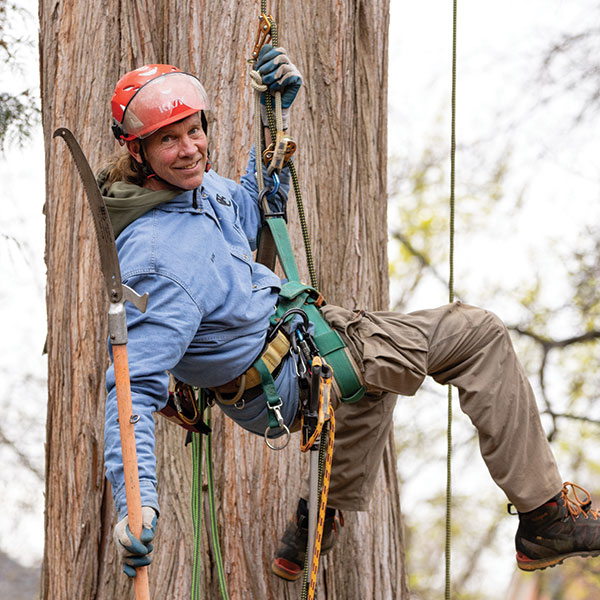A Whitman Tree Walk With Taha Ebrahimi ’01
Illustrations and captions by Taha Ebrahimi ’01
We asked Seattle street tree expert Taha Ebrahimi ’01 to turn her unique eye to the trees on and around Whitman’s campus. With hundreds of possibilities, she highlights a few trees of special interest. (Read more about about Ebrahimi’s journey to writing her 2024 bestseller “Street Trees of Seattle: An Illustrated Walking Guide.”)

1. Weeping Cherry (Prunus pendula Maximowicz)
Estimated to be 85 years old, this is the widest weeping cherry tree in Washington state. It is the harbinger of “sakura” flowering season, blooming pinkish-white in late March.

2. Wych Elm (Ulmus glabra)
Estimated to be the oldest tree on campus, this wych elm was likely planted when Hunter Conservatory (originally called the Music Conservatory) was completed in 1910 as part of a broader vision to expand the college’s reputation as an exceptional institution of higher learning or “The Yale of the West.” Not native anywhere near Washington state, an elm street tree at that time would have directly invoked New Haven, Connecticut (where Yale is located), which was nicknamed “Elm City” for its famously elm-lined streets. In the 1930s, after this elm was planted, a fungal infection—Dutch elm disease—decimated most elms on the East Coast, leaving this rare centenarian in Walla Walla as a reflection of what East Coast college towns used to look like. This is the only wych elm out of a handful of American and English elms that remain on or near campus, including two on the front lawn of Memorial Building.
3. Paper Birch (Betula papyrifera)
This is the only street tree in a sidewalk planting strip near campus that is originally native to Washington state. Named for its white, peeling bark, paper birches are often one of the first tree species to establish on land that has been recently disturbed by events like fire or avalanche.
4. Norway Spruce (Picea abies)
These Norway spruces are the only evergreen street trees in sidewalk planting strips near campus (19% of total trees on campus are evergreen). Norway spruce wood has been used to build instruments from violins to pianos.
5. Dawn Redwood (Metasequoia glyptostroboides)
This rare deciduous conifer is believed to have been propagated over 70 years ago from the original dawn redwood specimen first brought from China in the late 1940s. Once thought to be extinct, it is considered a “living fossil.”
6. Hackberry (Celtis occidentalis)
This 100-year old common hackberry has the widest trunk diameter of its species in the state of Washington. It’s such an overlooked tree in this region that it is often called the “Unknown Tree.” Look for its small berries that sometimes persist through winter or its gray, corky bark pocked by warty growth.
7. Golden Rain Tree (Koelreuteria paniculata)
This tree has the widest crown of any golden rain tree in Washington. Seeds were brought from China to France by Jesuits in the 1700s and later sent to Thomas Jefferson, who planted the first one in the U.S. in 1809. Spikes of yellow flowers appear in August, followed in fall by orange pods.

8. London Plane (Platanus × acerifolia)
This iconic tree next to Memorial Building was the first plane tree to be planted on or near campus roughly 100 years ago. The London plane got its name from being ubiquitously planted throughout London during the Industrial Revolution when factory smoke polluted the air and few other trees could tolerate the grim conditions. Its superpower is its ability to protect itself via exfoliation when its distinctive puzzle-shaped bark flakes off, removing harmful pollutants and leaving a new, healthy layer behind. Easily identified among other plane trees by its lumpy, burly appearance, the London plane’s resilience is the result of genetic diversity, being the offspring of an American sycamore (Platanus occidentalis) native to the eastern and central U.S., Canada and parts of Mexico, crossed with an oriental plane (Platanus orientalis) native from Italy to Iran.
9. Silver Maple (Acer saccharinum)
This silver maple is the widest tree on campus (by trunk diameter) although it is relatively young at 65 years old. Often planted because they grow very fast, silver maples can be identified by their deeply furrowed, shaggy bark, and the silvery undersides of their five-lobed leaves.
10. Giant Sequoia (Sequoiadendron giganteum)
These three giant sequoias are only around 20 years old, but are able to grow an inch in diameter each year. This endangered species is native to only one place on Earth: the Sierra Nevada mountains of California, where fewer than 80,000 remain in the wild.
11. Northern Catalpa (Catalpa speciosa)
This street tree near the Phi Delta Theta fraternity blooms in June, bearing bell-shaped white flowers with purple and yellow markings that attract bee pollinators during the day, while its fragrance attracts moth pollinators at night. Northern catalpa are originally native to the Midwestern U.S., including Ohio—where the Phi Delta Theta fraternity was founded.

Whitman 💚s Trees
Whitman College has earned Tree Campus USA recognition from the Arbor Day Foundation, which honors colleges and universities that promote healthy trees and engage students, staff and faculty in the spirit of conservation. Who takes care of those trees? Meet Whitman College arborist and alum Kirk Huffey ’95.